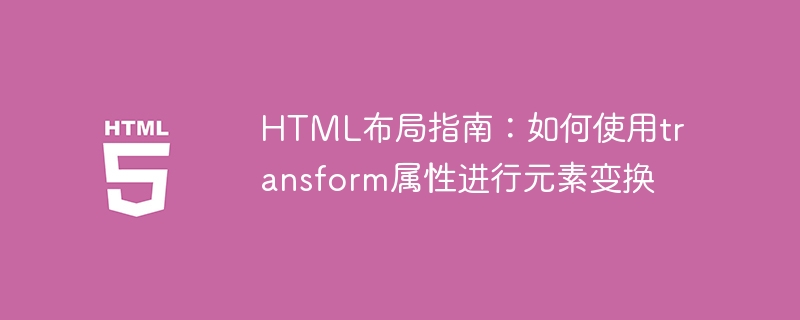

HTML Layout Guide: How to use the transform attribute to transform elements
In web design, layout is crucial. HTML and CSS are the main tools for implementing layout. In addition to traditional layout technology, CSS3 also provides a powerful attribute-the transform attribute, which can achieve various transformation effects of elements. This article will introduce in detail how to use the transform attribute to transform elements and provide specific code examples.
1. Basic introduction
Transform is a property of CSS3, used to transform elements. It can achieve effects such as translation, scaling, and rotation of elements. It is worth noting that transform only changes the visual presentation of the element, but does not affect the document flow of the element, so it will not affect the layout of other elements.
2. Translation transformation
Translation is the movement of elements in the horizontal or vertical direction. Translation transformation can be achieved through the translate() function of transform. The translate() function accepts two parameters, representing the displacement distance in the horizontal and vertical directions respectively.
The sample code is as follows:
.box {
transform: translate(100px, 50px);
}The above sample code will translate the .box class element to the right by 100 pixels and down by 50 pixels.
3. Scale transformation
Scale refers to the enlargement or reduction of elements in the horizontal and vertical directions. Scaling transformation can be achieved through the scale() function of transform. The scale() function accepts a parameter indicating the scaling ratio.
The sample code is as follows:
.box {
transform: scale(1.5);
}The above sample code enlarges the .box class element by 1.5 times in the horizontal and vertical directions.
4. Rotation Transformation
Rotation means that the element rotates a certain angle around a point. Rotation transformation can be achieved through the rotate() function of transform. The rotate() function accepts a parameter indicating the angle of rotation.
The sample code is as follows:
.box {
transform: rotate(45deg);
}The above sample code rotates the elements of the .box class counterclockwise 45 degrees.
5. Oblique transformation
Oblique means that the element produces a certain bevel effect in the horizontal and vertical directions. Skew transformation can be achieved through the skew() function of transform. The skew() function accepts two parameters, representing the tilt angle in the horizontal and vertical directions respectively.
The sample code is as follows:
.box {
transform: skew(30deg, 10deg);
}The above sample code tilts the .box class element horizontally by 30 degrees and vertically by 10 degrees.
6. Combination application of transformation
The above introduces several basic transformation effects of the transform attribute. In actual applications, they can be combined and applied to achieve more complex effects.
The sample code is as follows:
.box {
transform: translate(100px, 50px) rotate(45deg) scale(1.5) skew(30deg, 10deg);
}The above sample code first translates the .box class elements in order, then rotates, then scales and tilts, and finally achieves a combination of multiple transformation effects. .
7. Compatibility considerations
The transform attribute is a new feature of CSS3, which may not be supported or incompletely supported in some older browsers. Therefore, when using the transform attribute, you should pay attention to compatibility issues and perform downgrade processing according to specific needs.
Conclusion
Through the introduction of this article, I believe you have understood how to use the transform attribute to transform elements. The transform attribute provides powerful capabilities that can help us achieve rich and diverse layout effects. I hope the content of this article will be helpful to everyone and improve your web layout capabilities.
The above is the detailed content of HTML layout guide: How to use the transform attribute to transform elements. For more information, please follow other related articles on the PHP Chinese website!
 What software is zoom?
What software is zoom?
 MySQL index
MySQL index
 Why is there no signal on the monitor after turning on the computer?
Why is there no signal on the monitor after turning on the computer?
 The role of base tag
The role of base tag
 Introduction to hard disk interface types
Introduction to hard disk interface types
 How to use googlevoice
How to use googlevoice
 The difference between JD.com's self-operated flagship store and its official flagship store
The difference between JD.com's self-operated flagship store and its official flagship store
 What does Matcha Exchange do?
What does Matcha Exchange do?




